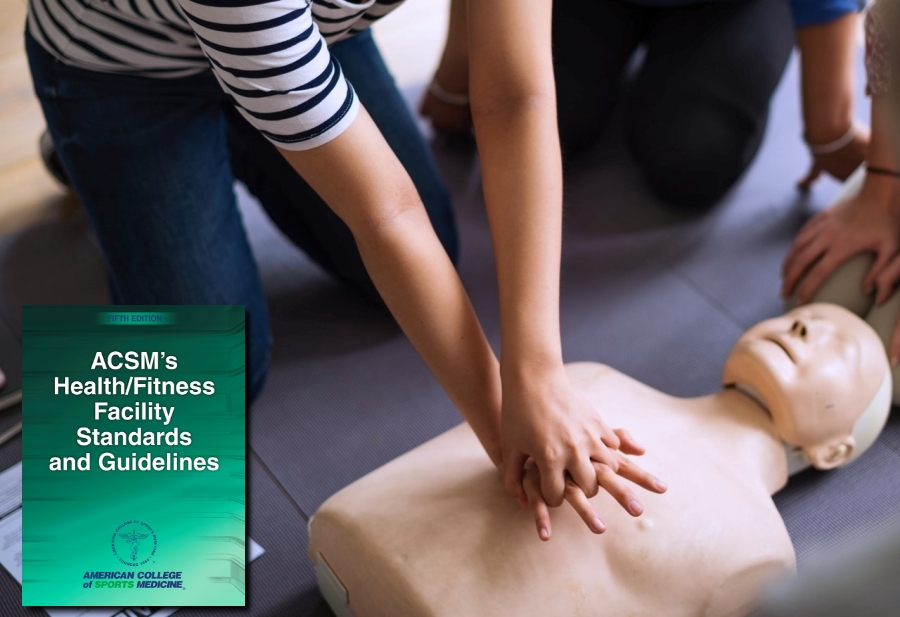Bill McBride and Daniel P. Connaughton, EdD, ACSM-EP |
July
25, 2019

Do you know what to do if an emergency happens at your facility?
Facility Safety is multi-faceted and everyone’s responsibility to ensure a safe environment for all users and all staff members. It is imperative to always be prepared for the worst with regard to anything that may happen from medical emergencies, fire, earthquake, flood, storm, power outages, staff and member hostility danger, active shooter, contamination, etc.
Do you know what to do if an emergency happens at your facility? The job task analysis (on which examination questions are based) for each of the ACSM Health Fitness certifications and the ACSM Clinical Exercise Physiologist certification, state that an exercise professional should know and/or be able to perform as part of their job, different aspects of preparing for and being involved in emergency situations:
- ACSM-GEI “Respond to emergencies to minimize untoward events by following procedures consistent with established standards of care and facility policies.” (Domain IV. Professional Responsibilities, section F)
- ACSM-CPT “Develop a comprehensive risk management program (including an emergency action plan and injury prevention program) consistent with industry standards of care” (Domain IV Legal and Professional Responsibilities, section B)
- ACSM-EP “Develop and disseminate risk management guidelines for a health/fitness facility to reduce member, employee, and business risk.” (Domain IV. Risk Management and Professional Responsibilities, section A)
- ACSM-CEP “Evaluate the exercise environment and perform regular inspections of any emergency equipment and practice emergency procedures (e.g., crash cart, activation of emergency procedures) per industry and regulatory standards and facility guidelines.” (Domain VI: Legal and Professional Responsibilities, section A)
Please refer to the individual job task analysis for the specific lists of knowledge and skills. Knowing what the documented emergency response system is for your facility is important to every certified professional.

ACSM’s Health/Fitness Facilities Standards and Guidelines, Fifth Edition provides standards and guidelines for emergency planning and policies that health/fitness facilities need to consider in order to provide a reasonably safe environment for employees, members and users. A foundational component is a written emergency response policy and procedure.
Emergency Planning and Policies Standard 1. Facility operators must have written emergency response policies and procedures, which shall be reviewed regularly and physically rehearsed a minimum of twice annually. These policies shall enable staff to respond to basic first-aid situations and other emergency events in an appropriate and timely manner.
Having an emergency response system is critical to providing a reasonably safe environment for members, users, and staff as well as being a sound risk management practice. For health/fitness facilities, emergency response systems must be developed in order to provide the highest reasonable level of safety for member and users.
If you’re not sure what the emergency response plan is for your facility, ask. Know what the plan is before an emergency arises. As an exercise professional, you can actively contribute to making sure your facility maintains up-to-date emergency policies and procedures. An example of a safety program manual is included ACSM’s Health/Fitness Facilities Standards and Guidelines, Fifth Edition. Safety plans, and particularly emergency plans, should not be copied or implemented directly from the example manual, from those published in textbooks, or from plans developed by other health/fitness organizations or facilities. It is important that individual plans and policies be specifically developed and tailored for each individual organization and facility. Every organization/facility has unique factors that must be carefully considered when developing such plans. These factors include, but are not limited to the:
- Type and nature or health/fitness program activities
- Number of clients or users and their demographics
- Staff size and training
- Facility size and layout
- Local EMS response time
Safety and emergency plans should be approved by a health/fitness organization’s management, legal counsel, insurance provider, and appropriate experts (e.g., a medical director or liaison, local EMS personnel).
You can learn more about current standards and guidelines for developing emergency planning and policies in ACSM’s Health/Fitness Facilities Standards and Guidelines, Fifth Edition.
Download your free sample
Authors:

Bill McBride
President & CEO, BMC3 – Bill McBride Consulting, Coaching & Club Management
Co-Founder, President & Chief Executive Officer, Active Wellness
Bill is a health club industry veteran with over 25 years of experience leading and managing all aspects of commercial health clubs, medical fitness centers, residential, community, multi-tenant and corporate fitness sites. He co-founded Active Wellness, LLC and owns a health club consultancy - BMC3. Bill has served as Chairman of the International Health, Racquet & Sportsclub Association (IHRSA) Board of Directors, President of the Mid-Atlantic Club Management Association (MACMA) and served on the Industry Advisory Board for the American Council of Exercise (ACE). He is actively engaged as an author on industry education, serves on several fitness related technology company Advisory Boards, serves on the Medical Wellness Association (MWA) as a Faculty Member and The Medical Fitness Network (MFN) Advisory Boards. He recently also served on the ACSM Facility Standards & Guidelines 5th Edition Committee as an Editor. Bill consults & speaks regularly on industry topics throughout the world.

Daniel P. Connaughton, EdD, ACSM-EP
Professor and Associate Dean for Faculty Affairs in the College of Health and Human Performance at the University of Florida
Prior to his career in academia, Dan held management positions in recreation, aquatic, and health/fitness programs. His teaching and research are primarily focused on the study of law, policy, and risk management in sport, recreation, and fitness programs. He has authored or coauthored three textbooks, several book chapters, and over 115 peer-reviewed research articles. Furthermore, he has served as the principal investigator on over $12.5 million of externally funded contracts and grants, including research funded by the AHA that investigated implementation constraints and risk management practices related to AED in sport and recreation programs. Over the course of his career, Dan has received several teaching and research awards. He is also a research fellow with the Sport and Recreation Law Association and the Research Consortium of SHAPE America.
